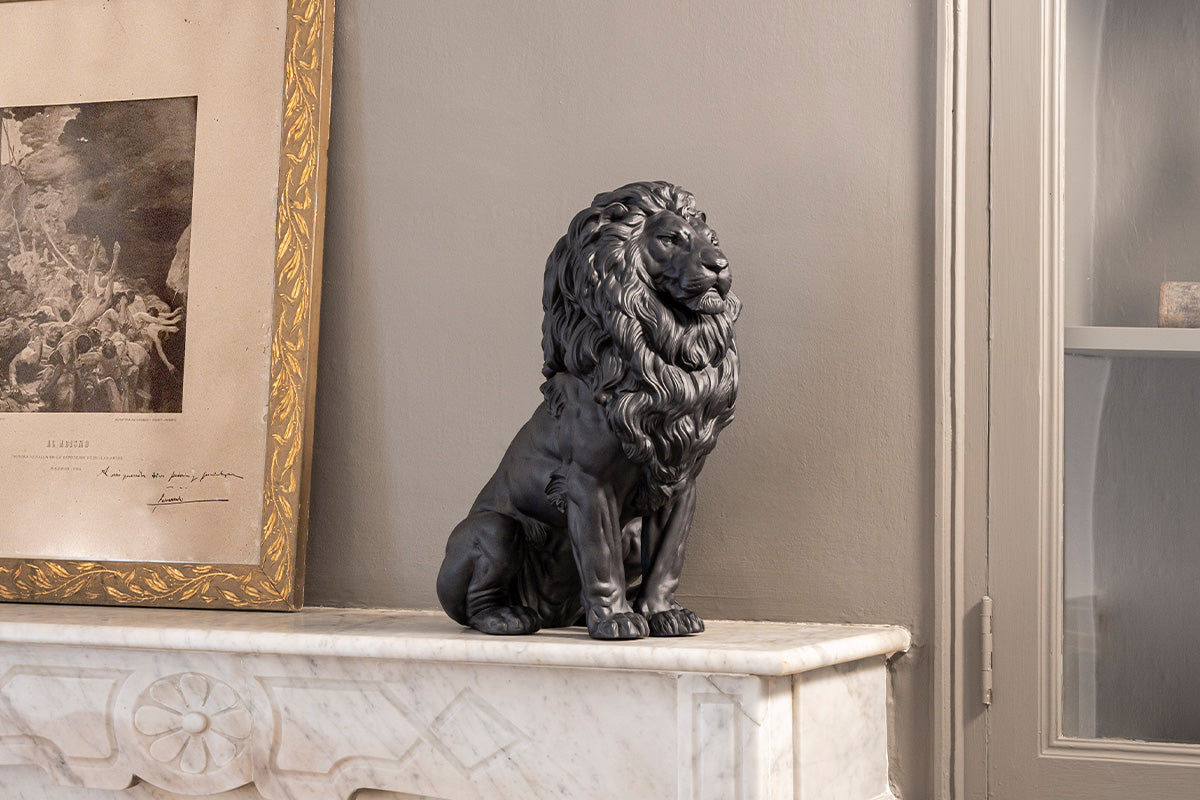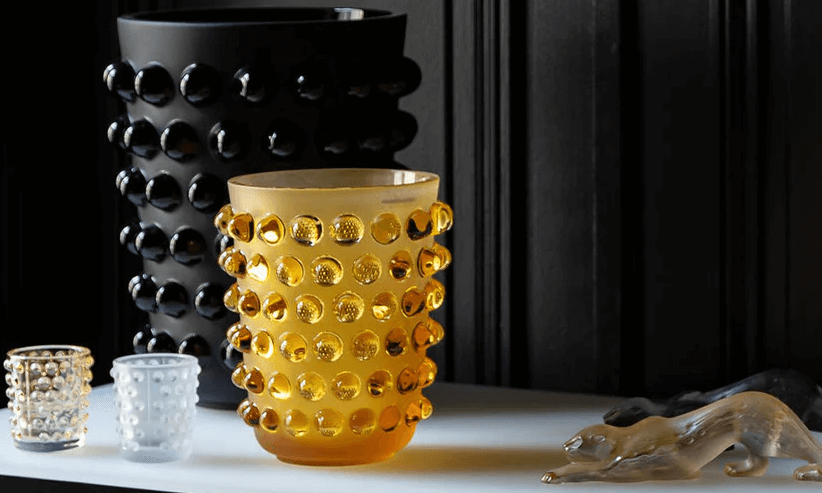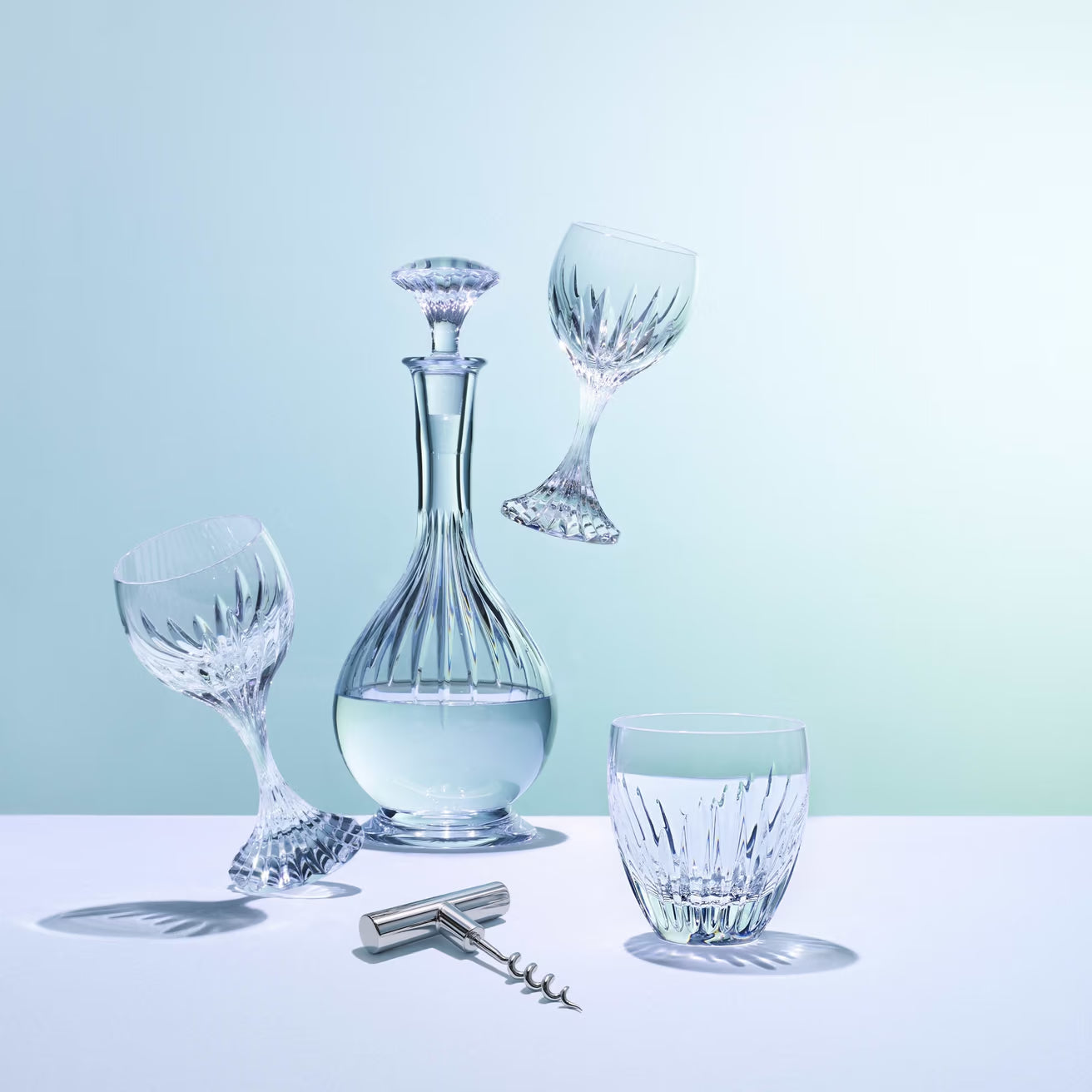Seven Lalique Icons: Unveiling the Stories Behind Crystal Masterpieces
Tagged with:About Lalique
Share

Lalique has long been synonymous with unrivalled artistry and innovation in crystal design. Throughout its storied history, the brand has produced a remarkable array of pieces that blend technical mastery with artistic vision. Among these, certain creations have stood the test of time, becoming symbols of Lalique’s heritage and craftsmanship. Each piece tells a story of inspiration, exquisite design, and the legacy of a family dedicated to pushing the boundaries of decorative arts. Here, we celebrate seven of Lalique’s most iconic creations (in no particular order!).
1. Bacchantes Vase

The Bacchantes Vase is a powerful representation of the untamed spirit and wild beauty of ancient mythology. The design was inspired by the Bacchantes, the female followers of Bacchus, the Roman god of wine, ecstasy, and revelry. These women were often depicted in classical mythology as liberated figures who abandoned the constraints of society and indulged in raucous celebrations that blurred the line between the human and divine. They were known for their ecstatic dances, wild intoxication, and unrestrained abandon, worshipping Bacchus through a frenzy of physical movement, music, and the consumption of wine. Lalique, an artist deeply connected to nature and the symbolism of the human form, sought to capture this essence of abandon and freedom in a highly stylised and abstract form.
Created in 1927, during the height of the Art Deco movement, the Bacchantes Vase embodies the era’s fascination with sensuality, mythology, and the celebration of femininity. The vase is sculpted in relief, showing the bacchantes dancing in an eternal circle, their bodies entwined in a dynamic, flowing rhythm. Their expressions are serene yet intense, their hair flowing and blending with the movement of their bodies, suggesting both wild energy and an ethereal connection to the divine. The use of transparent and frosted glass creates a striking contrast between the smooth surfaces of the dancers and the matte, textured background, enhancing the dramatic effect of the figures as they seem to leap out of the vase.
The Bacchantes Vase was one of Lalique's most significant works, capturing the essence of his ability to blend mythology with modern design. The figures of the bacchantes, while rooted in ancient Greek and Roman culture, also symbolise the ideals of freedom and liberation that were becoming more prominent in the 1920s, particularly in the wake of World War I. The post-war period saw a societal shift toward breaking with tradition, and Lalique's Bacchantes Vase reflected this desire for both artistic and personal freedom. The piece was celebrated for its innovative use of glass, a medium that Lalique had mastered, and for its bold representation of feminine energy and sensuality.
Beyond its aesthetic and pure craftsmanship, the Bacchantes Vase is a story of human desire, divine worship, and the transformative power of art. It embodies the idea of women as agents of both creation and destruction, participating in rites that connected them to the earth and to the divine through physical expression. Lalique’s interpretation of this mythic theme transformed a piece of glass into a living testament to the passions and power of the ancient world, bringing them into the modern era with a strikingly contemporary vision.
2. Mossi Vase

The Mossi Vase by Lalique is a stunning piece of art that tells a story of nature’s raw beauty and the deep connection between the natural world and the artistic imagination. Created in 1927, this vase is part of Lalique’s exploration of organic forms and his fascination with the textures and shapes found in nature. The name "Mossi" refers to the intricate, moss-like patterns that cover the surface of the vase, which are created through a unique method of molding and finishing that mimics the appearance of delicate plant life. Lalique’s ability to transform glass into something that feels as if it’s been shaped by natural forces, like wind or water, gives the Mossi Vase a sense of life, as though the glass itself were a living organism.
The design of the Mossi Vase is both abstract and highly textured. The surface of the vase is adorned with clusters of bubbles and frosted glass that resemble moss or lichen growing in a pattern that is both irregular and mesmerising. This treatment gives the vase a tactile quality, making it feel as though the viewer could run their fingers over the textured surface and feel the delicate ridges of the plant-like forms. The vase was revolutionary for its time, pushing the boundaries of what was possible with glass and challenging the conventions of traditional vase designs. Lalique's use of frosted glass, which was becoming a hallmark of his work, adds depth and contrast, giving the piece a soft, velvety appearance that feels simultaneously delicate and robust.
The Mossi Vase is deeply symbolic of Lalique’s understanding of nature. His love of the natural world, especially the plant and animal forms, had been a consistent source of inspiration throughout his career. In the aftermath of World War I, there was a marked shift in the cultural landscape, and Lalique’s work reflected this yearning for renewal, both in nature and in art. The Mossi Vase can be seen as a celebration of the earth’s resilience and the way in which life constantly renews itself. The vase’s appearance suggests the vitality of a growing organism, in tune with the rhythms of nature, where delicate mosses flourish in the most unlikely of places.
3. Champs Élysées Bowl

The Champs Élysées Bowl design is marked by stylised motifs reminiscent of the trees that line Paris’ renowned Avenue des Champs-Élysées. The flowing lines suggestive of movement and the polished finish evokes the luxurious feel of Paris itself. The bowl’s shape is geometric, with soft, curving lines that echo the avenue’s own blend of nature and urbanisation. Lalique’s use of contrasting matte and polished surfaces adds a sense of depth, suggesting the changing light and shadows that fall along the boulevard throughout the day.
What makes the Champs Élysées Bowl unique in Lalique's body of work is the way it combines his mastery of glass work with an abstract interpretation of a real-world location. The bowl's form and texture do not directly mimic the avenue but instead evoke the sense of movement and grace associated with the iconic Parisian street. The motifs on the surface are abstract representations of nature and urban life, giving the piece a modern, streamlined elegance that was in line with the Art Deco movement. Lalique’s precision in creating this balance between nature and artifice reflects his deep understanding of both the material world and the aesthetic spirit of his time.
This piece quite beautifully encapsulates the intersection of nature and modern art, representing the harmonious blend of organic and geometric forms that defined the period. Lalique's work is known for its ability to transform everyday materials, such as glass, into objects of timeless beauty, and the Champs Élysées Bowl stands as one of his most notable creations. It is not merely a decorative object but a masterpiece that embodies the spirit of Paris in the 1920s, a city at the forefront of artistic and cultural innovation.
4. Fish Sculpture


5. Zeila Panther Sculptures

The Zeila Panther Sculpture is one of Lalique's most striking and dynamic designs, created by Marie-Claude Lalique, the granddaughter of the company’s founder, René Lalique. Unveiled in 1998, this piece exemplifies Lalique's tradition of combining fine artistry with impeccable artisanship, bringing to life one of nature’s most majestic creatures. Inspired by the sleek, muscular form of the panther, the sculpture captures the animal in motion; its body coiled, ready to pounce. This portrayal conveys both the raw power and fluid grace of the panther, characteristic of Marie-Claude's deep respect for wildlife and her skillful ability to capture such creatures in crystal.
Unlike many traditional depictions of wildlife in sculpture, Marie-Claude's interpretation focuses on movement and emotion. The panther’s form is not just static; it is dynamic, with every muscle sculpted to express potential energy. The fine detailing, including the meticulously sculpted spots on the panther’s body, enhances the texture and plays with light across the crystal surface, further amplifying the sense of life within the sculpture.
Crafted from the finest crystal, the Zeila Panther is available in both large and small versions, allowing collectors to appreciate the intricate artisanship from distinct perspectives. The surface of the sculpture is textured with thousands of tiny, hand-carved spots, which not only replicate the natural pattern of the panther’s coat but also create a shimmering effect that adds depth and dimension. The careful contrast between the smooth, polished surfaces and the rougher, matte areas highlights the animal’s sleekness and agility while emphasising the fluidity of the pose.
6. La Terre Bleue Yves Klein™ by Lalique 2015 Limited Edition

La Terre Bleue Yves Klein™ is a limited-edition sculpture created in 2015 through a collaboration between Lalique and the estate of the renowned French artist Yves Klein. The piece is a direct reinterpretation of Klein’s visionary concept of the Earth as a sphere, rendered in his signature International Klein Blue (IKB). Klein, who famously developed IKB in the 1950s, used the colour as a means to evoke the infinite and the spiritual. Lalique’s reinterpretation of this idea in crystal merges Klein’s exploration of colour with the brand’s expertise in fine workmanship.
The sculpture features a spherical crystal form, designed to evoke the concept of Earth suspended in space. Lalique employed its lost-wax casting technique to create the piece, which allows for precise detailing and a smooth, polished surface. The blue hue, achieved by blending cobalt and copper oxides into the crystal, is a direct homage to Klein’s trademark colour. The piece is intentionally light, yet visually substantial, with its translucency and depth highlighting both the aesthetic and technical precision of Lalique’s crystal-making process.
La Terre Bleue represents a fusion of Klein’s minimalist, monochromatic art with Lalique’s century-long legacy of high-end crystal artistry. The limited-edition nature of the sculpture adds to its exclusivity, making it a collector's item. The piece is significant not only as a representation of Klein’s artistic ideas but also as a demonstration of Lalique’s capacity to merge modern artistic concepts with traditional craftsmanship.
7. Languedoc Vase

Designed by René Lalique in 1929, the Languedoc Vase is a striking example of the designer’s ability to fuse natural inspiration with technical expertise. Named after the Languedoc region in the south of France, the vase pays tribute to the distinctive landscape and vegetation of the area, with a particular focus on the cactus plants native to the region. Lalique often looked to the natural world for inspiration, and the Languedoc Vase is one of the clearest expressions of this influence, with its overlapping patterns mirroring the shape and texture of cactus leaves. The design is a direct reflection of Lalique’s skill at interpreting the rhythms and details of nature in glass, elevating a simple motif into an extraordinary work of art.
Crafted from satin-finished crystal, the vase features a surface treatment that gives it a soft, luminous glow, highlighting the intricate relief patterns of the cactus-inspired design. The use of re-polished crystal in specific areas adds a level of contrast to the texture, making the vase’s surface come to life with varying degrees of light and shadow. This interplay of matte and polished crystal is characteristic of Lalique’s style, creating depth and dimension that enhances the tactile and visual appeal of the piece. The vase's bold texture and generous proportions make it a commanding presence, not just as a functional object, but as a statement of Lalique’s artistic innovation.
As a product of Lalique's Art Deco period, the Languedoc Vase also speaks to the era's broader fascination with geometric and natural forms. The vase's design bridges the gap between modernist abstraction and the natural world, showcasing Lalique’s ability to integrate these two influences. Today, the Languedoc Vase remains a key example of René Lalique’s legacy, illustrating his mastery of crystal and his capacity to turn everyday elements into objects of exceptional beauty and artistic value. Nearly a century after its creation, the vase still stands as a testament to Lalique’s visionary approach to glassmaking and his ongoing influence on decorative arts.
If you enjoyed this article, check out:
- Lladró Fall 2024 Releases - Our Highlights
- Bold Blue: Homage to Artist Yves Klein
- Lladró Spring 2024 Releases




